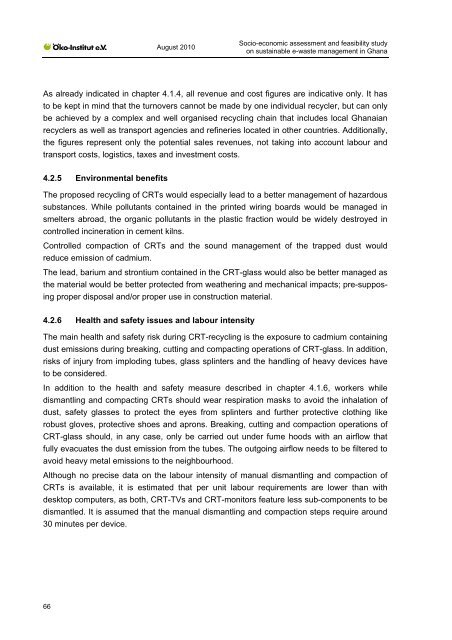Socio-economic assessment and feasibility study on - Öko-Institut eV
Socio-economic assessment and feasibility study on - Öko-Institut eV
Socio-economic assessment and feasibility study on - Öko-Institut eV
You also want an ePaper? Increase the reach of your titles
YUMPU automatically turns print PDFs into web optimized ePapers that Google loves.
66<br />
August 2010<br />
<str<strong>on</strong>g>Socio</str<strong>on</strong>g>-<str<strong>on</strong>g>ec<strong>on</strong>omic</str<strong>on</strong>g> <str<strong>on</strong>g>assessment</str<strong>on</strong>g> <str<strong>on</strong>g>and</str<strong>on</strong>g> <str<strong>on</strong>g>feasibility</str<strong>on</strong>g> <str<strong>on</strong>g>study</str<strong>on</strong>g><br />
<strong>on</strong> sustainable e-waste management in Ghana<br />
As already indicated in chapter 4.1.4, all revenue <str<strong>on</strong>g>and</str<strong>on</strong>g> cost figures are indicative <strong>on</strong>ly. It has<br />
to be kept in mind that the turnovers cannot be made by <strong>on</strong>e individual recycler, but can <strong>on</strong>ly<br />
be achieved by a complex <str<strong>on</strong>g>and</str<strong>on</strong>g> well organised recycling chain that includes local Ghanaian<br />
recyclers as well as transport agencies <str<strong>on</strong>g>and</str<strong>on</strong>g> refineries located in other countries. Additi<strong>on</strong>ally,<br />
the figures represent <strong>on</strong>ly the potential sales revenues, not taking into account labour <str<strong>on</strong>g>and</str<strong>on</strong>g><br />
transport costs, logistics, taxes <str<strong>on</strong>g>and</str<strong>on</strong>g> investment costs.<br />
4.2.5 Envir<strong>on</strong>mental benefits<br />
The proposed recycling of CRTs would especially lead to a better management of hazardous<br />
substances. While pollutants c<strong>on</strong>tained in the printed wiring boards would be managed in<br />
smelters abroad, the organic pollutants in the plastic fracti<strong>on</strong> would be widely destroyed in<br />
c<strong>on</strong>trolled incinerati<strong>on</strong> in cement kilns.<br />
C<strong>on</strong>trolled compacti<strong>on</strong> of CRTs <str<strong>on</strong>g>and</str<strong>on</strong>g> the sound management of the trapped dust would<br />
reduce emissi<strong>on</strong> of cadmium.<br />
The lead, barium <str<strong>on</strong>g>and</str<strong>on</strong>g> str<strong>on</strong>tium c<strong>on</strong>tained in the CRT-glass would also be better managed as<br />
the material would be better protected from weathering <str<strong>on</strong>g>and</str<strong>on</strong>g> mechanical impacts; pre-supposing<br />
proper disposal <str<strong>on</strong>g>and</str<strong>on</strong>g>/or proper use in c<strong>on</strong>structi<strong>on</strong> material.<br />
4.2.6 Health <str<strong>on</strong>g>and</str<strong>on</strong>g> safety issues <str<strong>on</strong>g>and</str<strong>on</strong>g> labour intensity<br />
The main health <str<strong>on</strong>g>and</str<strong>on</strong>g> safety risk during CRT-recycling is the exposure to cadmium c<strong>on</strong>taining<br />
dust emissi<strong>on</strong>s during breaking, cutting <str<strong>on</strong>g>and</str<strong>on</strong>g> compacting operati<strong>on</strong>s of CRT-glass. In additi<strong>on</strong>,<br />
risks of injury from imploding tubes, glass splinters <str<strong>on</strong>g>and</str<strong>on</strong>g> the h<str<strong>on</strong>g>and</str<strong>on</strong>g>ling of heavy devices have<br />
to be c<strong>on</strong>sidered.<br />
In additi<strong>on</strong> to the health <str<strong>on</strong>g>and</str<strong>on</strong>g> safety measure described in chapter 4.1.6, workers while<br />
dismantling <str<strong>on</strong>g>and</str<strong>on</strong>g> compacting CRTs should wear respirati<strong>on</strong> masks to avoid the inhalati<strong>on</strong> of<br />
dust, safety glasses to protect the eyes from splinters <str<strong>on</strong>g>and</str<strong>on</strong>g> further protective clothing like<br />
robust gloves, protective shoes <str<strong>on</strong>g>and</str<strong>on</strong>g> apr<strong>on</strong>s. Breaking, cutting <str<strong>on</strong>g>and</str<strong>on</strong>g> compacti<strong>on</strong> operati<strong>on</strong>s of<br />
CRT-glass should, in any case, <strong>on</strong>ly be carried out under fume hoods with an airflow that<br />
fully evacuates the dust emissi<strong>on</strong> from the tubes. The outgoing airflow needs to be filtered to<br />
avoid heavy metal emissi<strong>on</strong>s to the neighbourhood.<br />
Although no precise data <strong>on</strong> the labour intensity of manual dismantling <str<strong>on</strong>g>and</str<strong>on</strong>g> compacti<strong>on</strong> of<br />
CRTs is available, it is estimated that per unit labour requirements are lower than with<br />
desktop computers, as both, CRT-TVs <str<strong>on</strong>g>and</str<strong>on</strong>g> CRT-m<strong>on</strong>itors feature less sub-comp<strong>on</strong>ents to be<br />
dismantled. It is assumed that the manual dismantling <str<strong>on</strong>g>and</str<strong>on</strong>g> compacti<strong>on</strong> steps require around<br />
30 minutes per device.

















